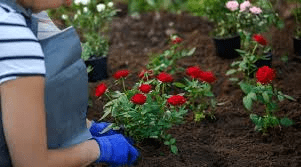Rose flowers are one of the most popular and widely traded flowers in the world. Their beauty and fragrance make them a favorite for various occasions, from personal gifts to large events. Processing, packaging, and exporting rose flowers involve several careful steps to ensure the flowers reach their destination in the best possible condition. This process starts from the cultivation of the roses to their preparation for export.
The first step in this process is cultivating the roses. Roses are usually grown in greenhouses or open fields, depending on the climate and available resources. Greenhouses offer a controlled environment where temperature, humidity, and light can be managed to produce high-quality flowers year-round. In open fields, roses are grown under natural conditions, but they may require more care to protect them from pests and diseases.
When growing roses, it is important to select the right variety. Different varieties of roses have different growth habits, flower colors, and scents. Some are more suitable for cut flowers, while others are better for gardens. The chosen variety should meet market demands and grow well in the local climate. Proper soil preparation, fertilization, and irrigation are also essential to ensure healthy plants and high yields.
Harvesting roses is done when the flowers are at the right stage of development. This is usually when the buds are partially open and the petals are just beginning to unfurl. Harvesting is typically done early in the morning when the temperatures are cooler and the flowers are more turgid. The stems are cut at an angle to increase the surface area for water absorption. Careful handling is crucial to prevent damage to the flowers and maintain their quality.
After harvesting, the roses are immediately placed in buckets of water to keep them hydrated. They are then transported to a processing facility where they are sorted and graded. Sorting involves separating the flowers based on their size, color, and quality. Grading is important because it determines the market value of the flowers and ensures that only the best quality roses are exported.
The next step is to prepare the roses for packaging. The stems are trimmed to the desired length, and any excess foliage or damaged leaves are removed. The flowers are then bunched together, usually in groups of a dozen or more. Each bunch is tied with a rubber band or floral tape to keep the stems together. Hydration solutions or preservatives may be added to the water in the buckets to extend the flowers’ vase life.
Packaging the roses involves placing the bunched flowers in protective sleeves or wrapping them in tissue paper. This helps to protect the petals and prevent them from getting bruised during transportation. The flowers are then placed in sturdy boxes that provide support and prevent movement. The boxes are lined with insulation material to maintain a cool temperature and prevent the flowers from wilting. Proper ventilation is also important to allow the flowers to breathe.
Labeling the packages is an important part of the process. Labels should include information such as the variety of roses, the date of harvest, the grower’s details, and any special handling instructions. Accurate labeling helps to ensure that the flowers are handled correctly throughout the supply chain and reach their destination in good condition.
Once packaged, the roses are stored in a cold room at a temperature of about 2-4°C (36-39°F). Cold storage slows down the respiration rate of the flowers and helps to maintain their freshness. The roses should be transported to the export facility as quickly as possible to minimize the time they spend out of cold storage.
Exporting roses involves complying with various international regulations and obtaining the necessary certifications. Exporters must ensure that the flowers meet the quality standards of the destination country. This may include phytosanitary certificates, which confirm that the flowers are free from pests and diseases. Other documentation may include certificates of origin and export licenses.
Transportation is a critical aspect of exporting roses. The flowers must be transported in refrigerated containers or trucks to maintain a consistent temperature. This is important to prevent the flowers from wilting or deteriorating during transit. For air transport, the roses are usually shipped as cargo in temperature-controlled compartments. Proper handling and loading are essential to prevent damage to the flowers.
Upon arrival in the destination country, the roses must go through customs clearance. This involves inspecting the documentation and the flowers to ensure they comply with the import regulations. If everything is in order, the roses are cleared for entry and can be distributed to wholesalers, retailers, or directly to consumers.
Processing, packaging, and exporting rose flowers require careful attention to detail at each step. From selecting the right variety and growing healthy plants to harvesting, sorting, and packaging the flowers, each stage is crucial in ensuring the roses reach their destination in excellent condition. Proper handling, cold storage, and compliance with export regulations are essential to maintaining the quality of the roses throughout their journey. By following best practices, growers and exporters can provide beautiful, fresh roses that delight customers around the world.
How to Process Rose Flowers for Exportation

1. Growing and Harvesting: Grow roses in well-drained soil with ample sunlight and water. Harvest the flowers early in the morning when they are at their freshest. Cut the stems at an angle to facilitate water absorption. Use clean, sharp tools to prevent damage and disease.
2. Sorting: Sort the harvested roses by size, color, and quality. Discard any damaged or diseased flowers. Sorting ensures uniformity and helps in meeting market standards.
3. Cleaning: Gently clean the roses to remove any dirt or insects. Use clean, cold water and avoid harsh chemicals that can damage the flowers. Ensure the roses are dry before moving to the next step.
4. Trimming: Trim the stems to the desired length, usually between 12-24 inches, depending on the market preference. Remove excess leaves and thorns, but keep a few leaves near the flower to aid in hydration.
5. Hydration and Conditioning: Place the trimmed roses in buckets of clean water with floral preservatives. This helps to extend their vase life and maintain freshness during transportation. Keep the flowers in a cool, shaded area for a few hours to condition them.
6. Cooling: Pre-cool the roses to a temperature of around 34-38°F (1-3°C) to slow down the metabolic processes and extend their shelf life. Use a refrigerated room or a cooling chamber for this process.
7. Grading: Grade the roses based on quality, length, and bloom stage. Common grades include Premium, Standard, and Fancy. Grading helps in pricing and market positioning.
8. Bunching: Group the roses into bunches, typically 10-25 stems per bunch, depending on the market requirements. Secure the bunches with rubber bands or floral ties. Ensure that the bunches are uniform and aesthetically pleasing.
9. Wrapping: Wrap the bunches in protective sleeves or paper to prevent damage during handling and transportation. Use breathable materials to allow air circulation and prevent moisture buildup.
10. Labeling: Label each bunch with information such as variety, grade, grower’s name, and country of origin. Accurate labeling helps in tracking and compliance with export regulations.
11. Pre-Cooling Before Packaging: Pre-cool the roses again before final packaging to ensure they are at the optimal temperature for transport. This step helps maintain their freshness during the journey.
12. Documentation: Prepare all necessary export documentation, including phytosanitary certificates, certificates of origin, and any other regulatory documents required by the importing country. Ensure that all documents are accurate and complete to avoid delays at customs.
Read Also: Tobacco Mosaic Virus: Description, Damages Caused, Control and Preventive Measures
How to Package Rose Flowers for Exportation

1. Selecting Packaging Materials: Choose high-quality packaging materials that protect the roses from physical damage, moisture, and temperature fluctuations. Common materials include corrugated cardboard boxes and plastic liners.
2. Box Preparation: Prepare the boxes by lining them with plastic or paper to prevent moisture absorption. Use dividers or inserts to keep the bunches separated and secure during transit.
3. Layering: Place the rose bunches in the boxes in layers, ensuring that the stems are aligned and the blooms are facing upwards. Avoid overpacking to prevent crushing the flowers.
4. Temperature Control: Use ice packs or gel packs to maintain a consistent temperature within the boxes. This is crucial for preventing heat buildup and maintaining the freshness of the roses.
5. Cushioning: Add cushioning materials such as foam or bubble wrap around the bunches to absorb shocks and vibrations during transport. This helps in preventing physical damage to the flowers.
6. Sealing: Seal the boxes securely with strong adhesive tape. Ensure that the boxes are sealed tightly to prevent any movement of the contents during transit.
7. Labeling: Label each box with information such as the type of roses, quantity, weight, handling instructions, and destination address. Use waterproof labels to ensure that the information remains legible.
8. Palletizing: Place the boxes on pallets for easier handling and transport. Secure the boxes to the pallets with stretch wrap or straps to prevent movement and damage during loading and unloading.
9. Insulated Containers: If the roses are being transported over long distances or in hot climates, consider using insulated containers to maintain a consistent temperature. This helps in preserving the quality of the flowers.
10. Final Inspection: Conduct a final inspection of the packaged roses to ensure that they meet quality standards and are ready for export. Address any issues before shipping.
How to Export Rose Flowers for Profits
1. Market Research: Conduct thorough market research to identify demand, competition, and pricing in potential export markets. Understand the preferences, regulatory requirements, and quality standards of consumers in these markets.
2. Regulatory Compliance: Familiarize yourself with the export regulations of your country and the import regulations of the target market. Ensure that your roses comply with all health, safety, and quality standards.
3. Certifications: Obtain necessary certifications such as organic or Fair Trade to enhance marketability and demonstrate commitment to sustainable practices. These certifications can increase consumer trust and access to premium markets.
4. Pricing Strategy: Develop a competitive pricing strategy that covers production, packaging, shipping, and other costs while ensuring profitability. Consider factors such as market demand, competition, and production costs.
5. Finding Buyers: Identify potential buyers through trade shows, online platforms, and industry networks. Establish relationships with importers, wholesalers, and retailers in the target market.
6. Negotiating Contracts: Negotiate clear and detailed contracts with buyers. Include terms of sale, payment methods, delivery schedules, and responsibilities of each party. Clear contracts prevent misunderstandings and disputes.
7. Logistics and Shipping: Plan the logistics of shipping, including selecting reliable shipping companies, managing documentation, and coordinating with freight forwarders. Efficient logistics ensure timely delivery and maintain product quality.
8. Quality Assurance: Implement strict quality control measures throughout processing, packaging, and shipping. Consistently high-quality products enhance your reputation and attract repeat business.
9. Marketing and Promotion: Develop a marketing strategy to promote your roses. Use online marketing, trade fairs, and industry publications to reach potential buyers and showcase the benefits of your products.
10. Monitor and Adapt: Continuously monitor market trends, customer feedback, and sales performance. Be prepared to adapt your strategies based on changing market conditions and customer needs to maximize profitability.
Read Also: Potato Virus Y: Description, Damages Caused, Control and Preventive Measures
Frequently Asked Questions (FAQ’s) About Rose Flowers

1. What is the best time to harvest roses?
The best time to harvest roses is early in the morning when they are at their freshest and most hydrated.
2. How should roses be stored before export?
Roses should be stored in a cool, dark, and humid environment, ideally at temperatures between 34-38°F (1-3°C).
3. What are the common packaging materials for roses?
Common packaging materials include corrugated cardboard boxes, plastic liners, foam, and bubble wrap.
4. How can I ensure the quality of exported roses?
Implementing strict quality control measures, proper grading, and maintaining optimal storage conditions are essential for ensuring quality.
5. What certifications are needed for exporting roses?
Certifications such as organic, Fair Trade, and phytosanitary certificates may be required depending on the importing country’s regulations.
6. How are roses graded for export?
Roses are typically graded based on quality, length, and bloom stage, with common grades being Premium, Standard, and Fancy.
7. What are the key export markets for roses?
Key markets include the United States, Europe, Japan, and the Middle East, which have high demand for high-quality roses.
8. How should roses be transported to maintain freshness?
Roses should be transported in refrigerated containers or with ice packs to maintain a consistent temperature and prevent heat buildup.
9. How can I find buyers for my roses?
Participate in trade shows, use online platforms, and network within the industry to find potential buyers.
10. What are the common challenges in exporting roses?
Challenges include maintaining quality standards, regulatory compliance, market competition, and managing logistics efficiently.

